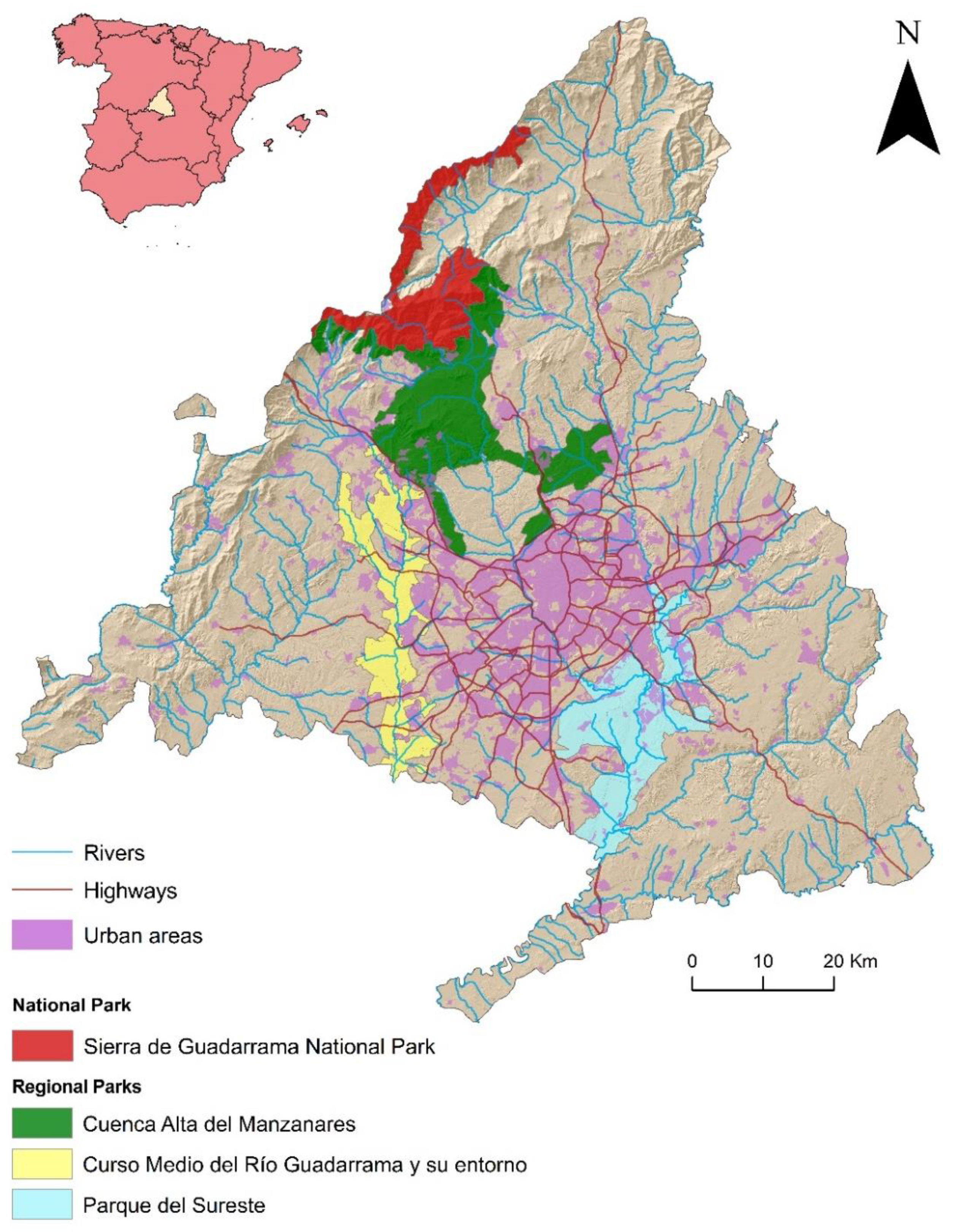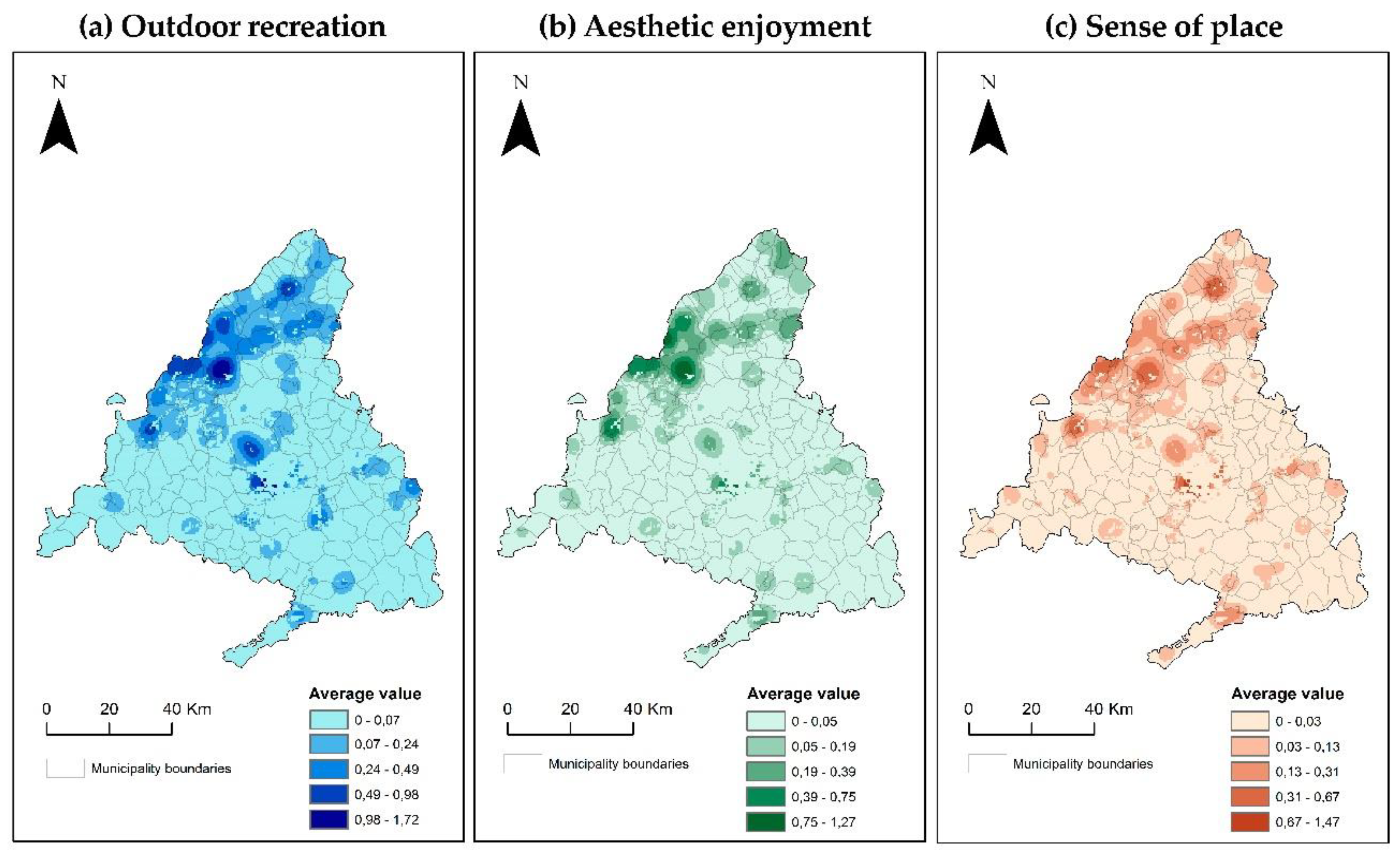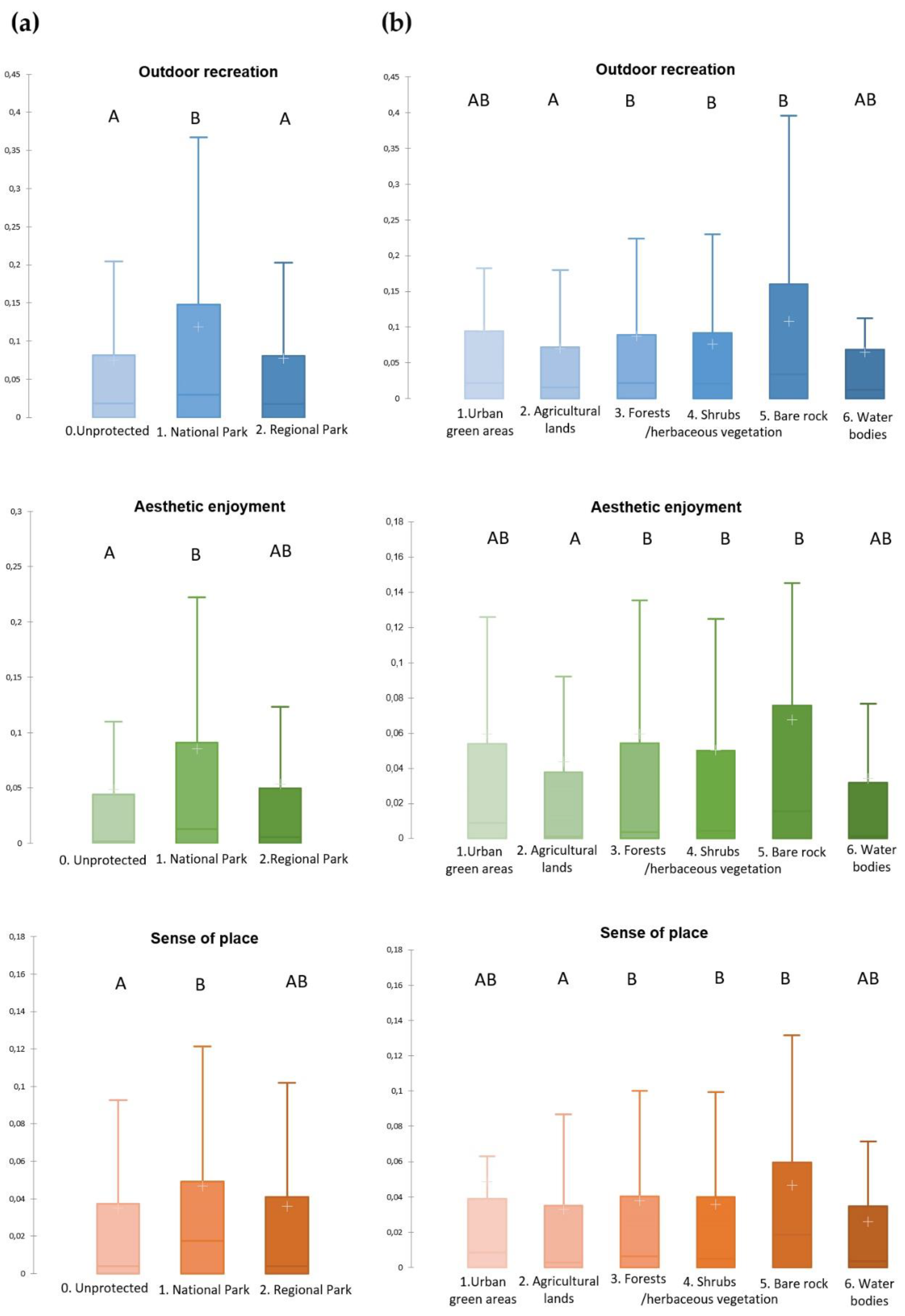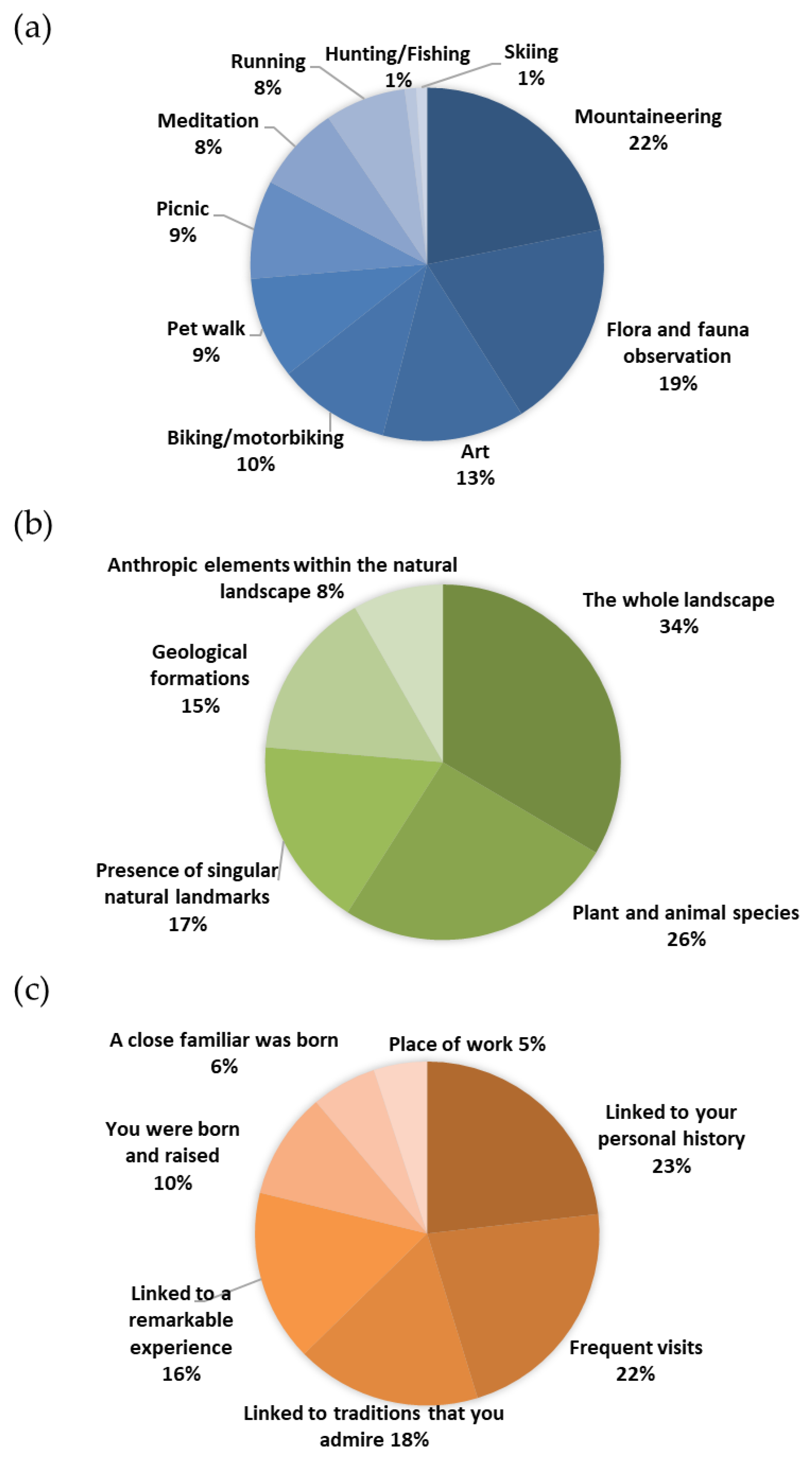Participatory Mapping of Cultural Ecosystem Services in Madrid: Insights for Landscape Planning
Abstract
1. Introduction
2. Materials and Methods
2.1. Study Area
2.2. Questionnaire Design
2.3. Survey Dissemination Strategy and Scope of Sampling
2.4. Data Analysis
3. Results
3.1. Geographical Distribution of CES and CES Hotspots
3.2. Relationship between Geographical Variables and the Supply of CES
3.3. Respondents’ Motivations for Associating Sites with CES and Well-Being
4. Discussion
4.1. Distribution of the Mapped CES
4.2. Relationship between Geographical Variables and the Supply of CES
4.3. CES Capacity to Mediate Human–Nature Connections and Well-Being
4.4. The Importance of Incorporating CES Mapping into Spatial Planning and Decision-Making
5. Conclusions
Author Contributions
Funding
Acknowledgments
Conflicts of Interest
References
- Pascual, U.; Balvanera, P.; Díaz, S.; Pataki, G.; Roth, E.; Stenseke, M.; Watson, R.T.; Başak Dessane, E.; Islar, M.; Kelemen, E.; et al. Valuing nature’s contributions to people: The IPBES approach. Curr. Opin. Environ. Sustain. 2017, 26–27, 7–16. [Google Scholar] [CrossRef]
- Díaz, S.; Pascual, U.; Stenseke, M.; Martín-López, B.; Watson, R.T.; Molnár, Z.; Hill, R.; Chan, K.M.A.; Baste, I.A.; Brauman, K.A.; et al. Assessing nature’s contributions to people. Science 2018, 359, 270–272. [Google Scholar] [CrossRef]
- Daniel, T.C.; Muhar, A.; Arnberger, A.; Aznar, O.; Boyd, J.W.; Chan, K.M.A.; Costanza, R.; Elmqvist, T.; Flint, C.G.; Gobster, P.H.; et al. Contributions of cultural services to the ecosystem services agenda. Proc. Natl. Acad. Sci. USA 2012, 109, 8812–8819. [Google Scholar] [CrossRef]
- Milcu, A.I.; Hanspach, J.; Abson, D.; Fischer, J. Cultural ecosystem services: A literature review and prospects for future research. Ecol. Soc. 2013, 18. [Google Scholar] [CrossRef]
- Ellis, E.C.; Pascual, U.; Mertz, O. Ecosystem services and nature’s contribution to people: Negotiating diverse values and trade-offs in land systems. Curr. Opin. Environ. Sustain. 2019, 38, 86–94. [Google Scholar] [CrossRef]
- Riechers, M.; Balázsi, Á.; Betz, L.; Jiren, T.S.; Fischer, J. The erosion of relational values resulting from landscape simplification. Landsc. Ecol. 2020, 1–12. [Google Scholar] [CrossRef]
- Plieninger, T.; Dijks, S.; Oteros-Rozas, E.; Bieling, C. Assessing, mapping, and quantifying cultural ecosystem services at community level. Land Use Policy 2013, 33, 118–129. [Google Scholar] [CrossRef]
- Kaltenborn, B.P.; Linnell, J.D.C.; Gómez-Baggethun, E. Can cultural ecosystem services contribute to satisfying basic human needs? A case study from the Lofoten archipelago, northern Norway. Appl. Geogr. 2020, 120. [Google Scholar] [CrossRef]
- Burkhard, B.; Maes, J. (Eds.) Mapping Ecosystem Services; Pensoft Publishers: Sofia, Bulgaria, 2017. [Google Scholar]
- Crossman, N.D.; Burkhard, B.; Nedkov, S.; Willemen, L.; Petz, K.; Palomo, I.; Drakou, E.G.; Martín-Lopez, B.; McPhearson, T.; Boyanova, K.; et al. A blueprint for mapping and modelling ecosystem services. Ecosyst. Serv. 2013, 4, 4–14. [Google Scholar] [CrossRef]
- Egoh, B.; Rouget, M.; Reyers, B.; Knight, A.T.; Cowling, R.M.; van Jaarsveld, A.S.; Welz, A. Integrating ecosystem services into conservation assessments: A review. Ecol. Econ. 2007, 63, 714–721. [Google Scholar] [CrossRef]
- Egoh, B.; Reyers, B.; Rouget, M.; Richardson, D.M.; Le Maitre, D.C.; van Jaarsveld, A.S. Mapping ecosystem services for planning and management. Agric. Ecosyst. Environ. 2008, 127, 135–140. [Google Scholar] [CrossRef]
- Chan, K.M.A.; Guerry, A.D.; Balvanera, P.; Klain, S.; Satterfield, T.; Basurto, X.; Bostrom, A.; Chuenpagdee, R.; Gould, R.; Halpern, B.S.; et al. Where are Cultural and Social in Ecosystem Services? A Framework for Constructive Engagement. Bioscience 2012, 62, 744–756. [Google Scholar] [CrossRef]
- Oteros-Rozas, E.; Martín-López, B.; Fagerholm, N.; Bieling, C.; Plieninger, T. Using social media photos to explore the relation between cultural ecosystem services and landscape features across five European sites. Ecol. Indic. 2018, 94, 74–86. [Google Scholar] [CrossRef]
- Fisher, D.M.; Wood, S.A.; Roh, Y.-H.; Kim, C.-K. The Geographic Spread and Preferences of Tourists Revealed by User-Generated Information on Jeju Island, South Korea. Land 2019, 8, 73. [Google Scholar] [CrossRef]
- Karasov, O.; Heremans, S.; Külvik, M.; Domnich, A.; Chervanyov, I. On how crowdsourced data and landscape organisation metrics can facilitate the mapping of cultural ecosystem services: An Estonian case study. Land 2020, 9, 158. [Google Scholar] [CrossRef]
- Fagerhom, N.; Käyhkö, N. Participatory mapping and geographical patterns of the social landscape values of rural communities in Zanzibar, Tanzania. Fenn. J. Geogr. 2009, 187, 43–60. [Google Scholar]
- Nahuelhual, L.; Carmona, A.; Laterra, P.; Barrena, J.; Aguayo, M. A mapping approach to assess intangible cultural ecosystem services: The case of agriculture heritage in Southern Chile. Ecol. Indic. 2014, 40, 90–101. [Google Scholar] [CrossRef]
- Ridding, L.E.; Redhead, J.W.; Oliver, T.H.; Schmucki, R.; McGinlay, J.; Graves, A.R.; Morris, J.; Bradbury, R.B.; King, H.; Bullock, J.M. The importance of landscape characteristics for the delivery of cultural ecosystem services. J. Environ. Manag. 2018, 206, 1145–1154. [Google Scholar] [CrossRef]
- Himes, A.; Muraca, B. Relational values: The key to pluralistic valuation of ecosystem services. Curr. Opin. Environ. Sustain. 2018, 35, 1–7. [Google Scholar] [CrossRef]
- Turner, W.R.; Nakamura, T.; Dinetti, M. Global Urbanization and the Separation of Humans from Nature. Bioscience 2004, 54, 585. [Google Scholar] [CrossRef]
- Langemeyer, J.; Camps-Calvet, M.; Calvet-Mir, L.; Barthel, S.; Gómez-Baggethun, E. Stewardship of urban ecosystem services: Understanding the value(s) of urban gardens in Barcelona. Landsc. Urban Plan. 2018, 170, 79–89. [Google Scholar] [CrossRef]
- Rall, E.; Bieling, C.; Zytynska, S.; Haase, D. Exploring city-wide patterns of cultural ecosystem service perceptions and use. Ecol. Indic. 2017, 77, 80–95. [Google Scholar] [CrossRef]
- Eurostat. Eurostat Regional Yearbook; 2019 Edition; Eurostat: Luxembourg, 2019.
- Comundad de Madrid. Evolución de la Ocupación del Suelo en la Comunidad de Madrid 1956–2005; Comunidad de Madrid: Madrid, Spain, 2005. [Google Scholar]
- Alexander Castanho, R.; Cabezas, J.; Naranjo Gómez, J.M.; Martín Gallardo, J.; Fernández-Pozo, L.; Yilmaz Genç, S.; Lousada, S.; Lourdes, L. Assessing Ecosystem Services Delivered by Public Green Spaces in Major European Cities. In Landscape Architecture: Processes and Practices Towards Sustainable Development; IntechOpen Limited: London, UK, 2020; p. 13. [Google Scholar] [CrossRef]
- Instituto de Estadística de la Comunidad de Madrid. Población total empadronada de Comunidad de Madrid; DESVAN. Banco de Datos Estructurales: Madrid, Spain, 2020. [Google Scholar]
- Pérez-Ramírez, I.; García-Llorente, M.; Benito, A.; Castro, A.J. Exploring sense of place across cultivated lands through public participatory mapping. Landsc. Ecol. 2019, 34, 1675–1692. [Google Scholar] [CrossRef]
- Jaligot, R.; Hasler, S.; Chenal, J. Participatory Mapping of Cultural Ecosystem Services in A Federal State: Lessons Learnt from Switzerland; ACES: Washington, DC, USA, 2018. [Google Scholar]
- Brown, G.; Fagerholm, N. Empirical PPGIS/PGIS mapping of ecosystem services: A review and evaluation. Ecosyst. Serv. 2015, 13, 119–133. [Google Scholar] [CrossRef]
- Alessa, L.; Kliskey, A.; Brown, G. Social-ecological hotspots mapping: A spatial approach for identifying coupled social-ecological space. Landsc. Urban Plan. 2008, 85, 27–39. [Google Scholar] [CrossRef]
- Sherrouse, B.C.; Clement, J.M.; Semmens, D.J. A GIS application for assessing, mapping, and quantifying the social values of ecosystem services. Appl. Geogr. 2011, 31, 748–760. [Google Scholar] [CrossRef]
- Brown, G.; Raymond, C.M.; Corcoran, J. Mapping and measuring place attachment. Appl. Geogr. 2015, 57, 42–53. [Google Scholar] [CrossRef]
- Tilliger, B.; Rodríguez-Labajos, B.; Bustamante, J.V.; Settele, J. Disentangling values in the interrelations between cultural ecosystem services and landscape conservation—A case study of the Ifugao Rice Terraces in the Philippines. Land 2015, 4, 888–913. [Google Scholar] [CrossRef]
- Bachi, L.; Ribeiro, S.C.; Hermes, J.; Saadi, A. Cultural Ecosystem Services (CES) in landscapes with a tourist vocation: Mapping and modeling the physical landscape components that bring benefits to people in a mountain tourist destination in southeastern Brazil. Tour. Manag. 2020, 77. [Google Scholar] [CrossRef]
- Ives, C.D.; Abson, D.J.; von Wehrden, H.; Dorninger, C.; Klaniecki, K.; Fischer, J. Reconnecting with nature for sustainability. Sustain. Sci. 2018, 13, 1389–1397. [Google Scholar] [CrossRef]
- Russell, R.; Guerry, A.D.; Balvanera, P.; Gould, R.K.; Basurto, X.; Chan, K.M.A.; Klain, S.; Levine, J.; Tam, J. Humans and Nature: How Knowing and Experiencing Nature Affect Well-Being. Annu. Rev. Environ. Resour. 2013, 38, 473–502. [Google Scholar] [CrossRef]
- Palomo, I.; Martín-López, B.; Potschin, M.; Haines-Young, R.; Montes, C. National Parks, buffer zones and surrounding lands: Mapping ecosystem service flows. Ecosyst. Serv. 2013, 4, 104–116. [Google Scholar] [CrossRef]
- Roux, D.J.; Smith, M.K.S.; Smit, I.P.J.; Freitag, S.; Slabbert, L.; Mokhatla, M.M.; Hayes, J.; Mpapane, N.P. Cultural ecosystem services as complex outcomes of people–nature interactions in protected areas. Ecosyst. Serv. 2020, 43. [Google Scholar] [CrossRef]
- Palomo, I.; Montes, C.; Martín-López, B.; González, J.A.; García-Llorente, M.; Alcorlo, P.; Mora, M.R.G. Incorporating the social-ecological approach in protected areas in the anthropocene. Bioscience 2014, 64, 181–191. [Google Scholar] [CrossRef]
- Brown, G.; Brabyn, L. An analysis of the relationships between multiple values and physical landscapes at a regional scale using public participation GIS and landscape character classification. Landsc. Urban Plan. 2012, 107, 317–331. [Google Scholar] [CrossRef]
- Peña, L.; Casado-Arzuaga, I.; Onaindia, M. Mapping recreation supply and demand using an ecological and a social evaluation approach. Ecosyst. Serv. 2015, 13, 108–118. [Google Scholar] [CrossRef]
- García-Llorente, M.; Martín-López, B.; Iniesta-Arandia, I.; López-Santiago, C.A.; Aguilera, P.A.; Montes, C. The role of multi-functionality in social preferences toward semi-arid rural landscapes: An ecosystem service approach. Environ. Sci. Policy 2012, 19–20, 136–146. [Google Scholar] [CrossRef]
- Brown, G. The relationship between social values for ecosystem services and global land cover: An empirical analysis. Ecosyst. Serv. 2013, 5, 58–68. [Google Scholar] [CrossRef]
- Kubalíková, L. Cultural ecosystem services of geodiversity: A case study from Stranska skala (Brno, Czech Republic). Land 2020, 9, 105. [Google Scholar] [CrossRef]
- Hermes, J.; Van Berkel, D.; Burkhard, B.; Plieninger, T.; Fagerholm, N.; von Haaren, C.; Albert, C. Assessment and valuation of recreational ecosystem services of landscapes. Ecosyst. Serv. 2018, 31, 289–295. [Google Scholar] [CrossRef]
- Delgado, L.E.; Marín, V.H. Ecosystem services: Where on earth? Ecosyst. Serv. 2015, 14, 24–26. [Google Scholar] [CrossRef]
- Calvet-Mir, L.; Gómez-Baggethun, E.; Reyes-García, V. Beyond food production: Ecosystem services provided by home gardens. A case study in Vall Fosca, Catalan Pyrenees, Northeastern Spain. Ecol. Econ. 2012, 74, 153–160. [Google Scholar] [CrossRef]
- Colding, J.; Gren, Å.; Barthel, S. The Incremental Demise of Urban Green Spaces. Land 2020, 9, 162. [Google Scholar] [CrossRef]
- Chan, K.M.A.; Balvanera, P.; Benessaiah, K.; Chapman, M.; Díaz, S.; Gómez-Baggethun, E.; Gould, R.; Hannahs, N.; Jax, K.; Klain, S.; et al. Why protect nature? Rethinking values and the environment. Proc. Natl. Acad. Sci. USA 2016, 113, 1462–1465. [Google Scholar] [CrossRef] [PubMed]
- Arias-Arévalo, P.; Gómez-Baggethunb, E.; Martín-López, B.; Pérez-Rincón, M. Widening the evaluative space for ecosystem services: A taxonomy of plural values and valuation methods. Environ. Values 2018, 27, 29–53. [Google Scholar] [CrossRef]
- Arias-Arévalo, P.; Martín-López, B.; Gómez-Baggethun, E. Exploring intrinsic, instrumental, and relational values for sustainable management of social-ecological systems. Ecol. Soc. 2017, 22. [Google Scholar] [CrossRef]
- Palomo, I.; Martín-López, B.; López-Santiago, C.; Montes, C. Participatory scenario planning for protected areas management under the ecosystem services framework: The Doñana social-ecological system in Southwestern Spain. Ecol. Soc. 2011, 16. [Google Scholar] [CrossRef]
- Hirons, M.; Comberti, C.; Dunford, R. Valuing Cultural Ecosystem Services. Annu. Rev. Environ. Resour. 2016, 41, 545–574. [Google Scholar] [CrossRef]





| Question | Closed-Ended Answers |
|---|---|
| General questions for every CES: | |
| Does this place belong to your municipality of residence? | (1) Yes. (2) No. (3) Do not know. |
| How often do you visit this place? | (1) Daily. (2) Weekly. (3) Monthly. (4) Every year. (5) Less than once a year. |
| Value the importance of this place to your personal well-being.1 | No importance (0__________100) Vital |
| Outdoor recreation: | |
| How long does it take you to reach this place? | (1) Less than 5 min. (2) Less than 30 min. (3) Less than one hour. (4) One hour or more. |
| What do you do at this place? | (1) Art (painting, photography, others). (2) Meditation. (3) Pet walking. (4) Flora and fauna observation. (5) Hunting/fishing. (6) Biking/motor biking. (7) Mountaineering (hiking, climbing). (8) Skiing. (9) Running. (10) Picnicking. (11) Other |
| With whom do you visit this place? | (1) Alone. (2) With friends. (3) With my partner. (4) With family. (5) With other people. |
| Aesthetic enjoyment: | |
| Which are the most attractive elements of this place? | (1) Presence of singular natural landmarks (stone monuments, waterfalls, unique trees). (2) Existent flora and fauna. (3) Geological formations. (4) The whole landscape. (5) The anthropic elements within the natural landscape. (6) Other. |
| Sense of place: | |
| What is it that links you to this place? | (1) You were born and raised here. (2) A close connection was born or raised here. (3) Frequent visits. (4) Place of work. (5) A remarkable experience. (6) Your personal history. (7) Traditions that you admire. (8) Other. |
| Environmental Factors 1 | Defined Categories | |
|---|---|---|
| Protected Areas |
| |
| Land Use |
|
|
| Agrarian Regions |
|
|
© 2020 by the authors. Licensee MDPI, Basel, Switzerland. This article is an open access article distributed under the terms and conditions of the Creative Commons Attribution (CC BY) license (http://creativecommons.org/licenses/by/4.0/).
Share and Cite
García-Díez, V.; García-Llorente, M.; González, J.A. Participatory Mapping of Cultural Ecosystem Services in Madrid: Insights for Landscape Planning. Land 2020, 9, 244. https://doi.org/10.3390/land9080244
García-Díez V, García-Llorente M, González JA. Participatory Mapping of Cultural Ecosystem Services in Madrid: Insights for Landscape Planning. Land. 2020; 9(8):244. https://doi.org/10.3390/land9080244
Chicago/Turabian StyleGarcía-Díez, Víctor, Marina García-Llorente, and José A. González. 2020. "Participatory Mapping of Cultural Ecosystem Services in Madrid: Insights for Landscape Planning" Land 9, no. 8: 244. https://doi.org/10.3390/land9080244
APA StyleGarcía-Díez, V., García-Llorente, M., & González, J. A. (2020). Participatory Mapping of Cultural Ecosystem Services in Madrid: Insights for Landscape Planning. Land, 9(8), 244. https://doi.org/10.3390/land9080244





